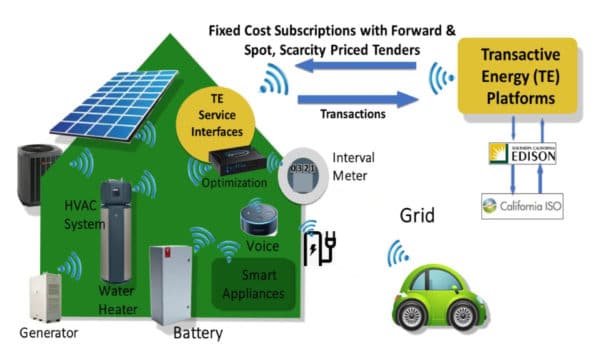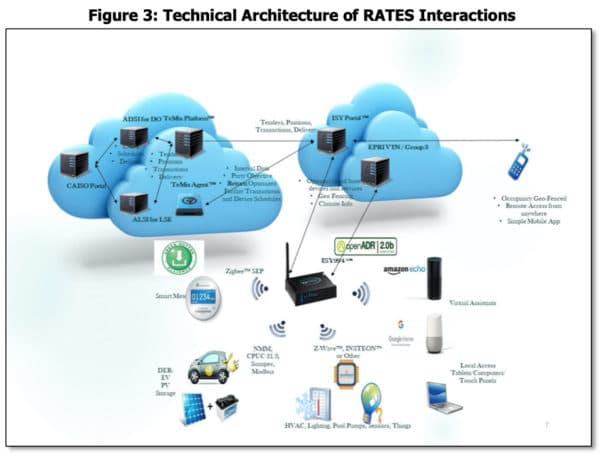A California project team offering customers real-time pricing of electricity has shown that the technology it developed works, and that customers shifted air conditioning load to periods of high solar generation, when electricity prices were lowest.
The California Energy Commission funded the project largely to demonstrate real-time pricing as a means to integrate increasing levels of renewable generation.
The project was technically complex. “Developing all the technical capabilities to calculate the prices and communicate them to such a wide range of devices is great work,” said Scott Murtishaw, senior advisor with the California Solar & Storage Association (CALSSA). “It sets a nice foundation for real-time pricing options for customers across California.”

The project, reaching 115 households and businesses on a single distribution circuit served by the utility SCE, was executed by Universal Devices and TeMix, in collaboration with SCE. An image developed by TeMix indicates the data, hardware and software involved.
Participating customers reduced their electric bills mostly by shifting air conditioning loads. “During the peak price hour, the customer’s air conditioner was typically off as a result of pre-cooling before the peak price hour,” explained TeMix CEO Dr. Edward Cazalet, who was lead author of a report on the project.
The response of air conditioners and heat pumps to price signals, “when implemented at scale, should have a major benefit to the grid in terms of reduced investment in flexible generation, especially with 100 percent clean energy,” says the report.
The 18-month pilot project also enabled customers to manage the timing of electric vehicle charging and battery storage operation.
“The big takeaway from this pilot is that it demonstrates that transactive energy systems can modify the timing of loads and can be implemented in a cost-effective way for both the consumer and the utility,” said Dynamic Grid CEO Kay Aikin. Dynamic Grid is developing a real-time pricing pilot based on different technology, for a microgrid serving Isle au Haut, a Maine coastal island.
Customer option
CalSSA in April called for state regulators to require the utility SDG&E to make real-time pricing an option in the San Diego area, after the group’s earlier call for a statewide option was tabled by regulators.
“We’ve argued in our filings,” said Murtishaw, “that this is the time to make real-time pricing available, because the capability is there, and increasingly so as we electrify transportation and residential end uses, besides the rapidly increasing adoption of storage.”
CALSSA’s main interest, he noted, is to “enable customers to get more value out of storage.”
The pilot project team designed the technology with scalability in mind, the report says. “All California independently operated utilities, community choice aggregators, and municipal utilities can develop projects” based on the piloted technology, say the authors, and the technology “can be scaled to many millions of customers.”
Technology
The report is chock-full of technical information, plus cost projections.
The real-time prices offered to customers participating in the pilot had four components, beginning with the real-time wholesale locational marginal price. Two other components, designed to preserve resource adequacy, were described as “scarcity-based dynamic price adders” for “base generation plus flex generation.” The fourth price component was a real-time distribution price, to recognize the capacity constraint of the distribution circuit.
A fixed monthly fee on each customer’s bill covered SCE’s per-customer costs for billing and other expenses.
The technical architecture of the device interactions is shown in the image below, developed by Universal Devices.
The pilot project team calls its real-time pricing system RATES, for Retail Automated Transactive Energy System. The California Energy Commission published the report, titled “Complete and Low-Cost Retail Automated Transactive Energy System (RATES).”

This content is protected by copyright and may not be reused. If you want to cooperate with us and would like to reuse some of our content, please contact: editors@pv-magazine.com.







By submitting this form you agree to pv magazine using your data for the purposes of publishing your comment.
Your personal data will only be disclosed or otherwise transmitted to third parties for the purposes of spam filtering or if this is necessary for technical maintenance of the website. Any other transfer to third parties will not take place unless this is justified on the basis of applicable data protection regulations or if pv magazine is legally obliged to do so.
You may revoke this consent at any time with effect for the future, in which case your personal data will be deleted immediately. Otherwise, your data will be deleted if pv magazine has processed your request or the purpose of data storage is fulfilled.
Further information on data privacy can be found in our Data Protection Policy.